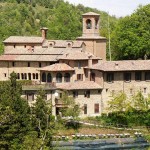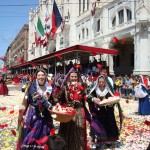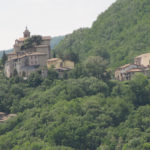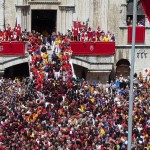A charming place where spending some days
St Benedict’s Sacro Speco (the Holy Cave)
Spiritual trekking in the area of Rome at Subiaco
The so called Sacro Speco in Subiaco is a place of hermitage that has become work of architecture and art. Here is the cave where the young Benedict took refuge from Rome and where he remained for three years, in prayer. First there was nothing, just the cave with some hermitages here and there.
Then, in 1200, a spectacular structure was built and it became a place of pilgrimage, and St Francis passed here too, by his time. You know, this place is important because here the journeys of the two Saints combines. St Benedict and St Francis had in common the idea of peace as their main teaching purpose.
⇒ Watch the full web serie Rieti & the holy valley
Thanks to Visit Lazio, Il Cammino di San Benedetto & MiBACT
Video full text: Saint Benedict’s Sacro Speco (Holy Cave)
Here it is, the Sacro Speco, an apparition.
A place of hermitage that has become work of architecture and art.
I’m due to meet Father Luigi Tiana here.
This slope is really testing me, Father Luigi.
But you’ll be recompensed because all of this!
So I see, it’s wonderful. It’s a vision! Tell me its history.
This is the cave where the young Benedict took refuge from Rome.
He remained here alone for three years, in prayer.
Then, in 1200, this spectacular structure was built.
First there was nothing, just the cave with some hermitages here and there.
It then became the place of pilgrimage.
The period around 1200 was the time of St. Francis.
And we have some evidence that he passed by the Sacro Speco here.
Francis, Patron Saint of Italy and Benedict, Patron Saint of Europe!
Two prominent individuals.
All of this was built and immaculately filled with frescoes.
Art is the only way of expressing not just the beauty of mankind but also that of God.
It is also a journey through the history of art,
from Byzantine to Renaissance art. Incredible!
We’re in the tallest part of this sanctuary.
Here we find the Sienese school that depicts the last part of the Jesus’ life.
His entry into Jerusalem, the garden of Gethsemane, the great crucifixion,
the resurrection and His ascension into heaven.
It’s like watching a movie shot in CinemaScope!
It’s the first method for teaching, the Bible for the poor.
Looking at these images allows excerpts of the Gospel to enter the hearts of pilgrims,
and to learn about the mystery of Jesus.
This school developed after Giotto,
and the movement that he brought as pictorial progress.
This marvellous depiction of the crucifixion shows some strangely dressed soldiers! How come?
Instead of wearing Roman uniforms they are dressed in the uniforms of the enemy of the time.
A snap shot of the crucifixion, but also of the moment in history when the Sanctuary was decorated.
This is a previous Umbro-Marchigiana School
This shows an important episode in Benedict’s life.
The monks found the Benedictine Rule too rigorous
and so they attempted to rid themselves of Benedict by offering him a cup of poisoned wine.
When Benedict blessed the cup with the sign of the cross, it shattered.
And so he survived this attempt to poison him.
Was this rule so hard that everybody was trying to poison him?
Quite the contrary because compared to previous, far stricter rules, it is very balanced.
Logically, however, it calls for seriousness and a life commitment.
It is a question of inventing a new social way of living together.
Precisely. Benedict is almost a “builder of civilisation”.
Saint Benedict is a well-read man, someone who has studied.
He was born into a Roman patrician family and was sent to Rome to attend attend a course of study that was typically patrician.
His studies therefore were not just classical but also scientific.
He founded a great movement, western Benedictine monasticism,
that was to develop a number of researches that included scientific ones.
One need only think of the seismograph in Perugia, invented by a Benedictine.
He was a utopian who created through a life code that is the rule.
There’s something interesting here, a very beautiful and symbolic image.
The devil has been imprisoned outside of the sanctuary and the church
and he actually bites his fingers because he can’t get in.
You managed to throw him into jail!
Let’s go and see the cave where Benedict came to be a hermit.
Then he was just Benedict, a youngster of sixteen.
The mammoth production continues here, all totally frescoed.
With splendid examples of paintings.
We’re in the middle part of the sanctuary, where the entrance to the cave can be found,
the so-called Speco surrounded by scenes from the saint’s life.
For example, this is another scene – the priest Fiorenzo is jealous of Benedict’s presence and sanctity,
and he offers him a gift of poisoned bread.
This time too he is saved because a crow carries the bread far from Benedict,
so that it cannot threaten his life and his followers.
People try in any way they can, but they are unable to poison him!
Over there we can see part of the cave, it’s all painted but at a certain point the rock arrives.
The construction leans against Benedict’s cave to watch over it.
This is where he came to be a hermit.
And this is where he lived in solitude and prayer for three years.
As we can see, it is bare rock,
because it is here that Benedict learned that one must leave everything behind in order to build something new.
The caves where hermits went to meditate are a constant feature.
They would go there to receive a revelation, to make contact with the transcendental.
But also to understand what is necessary in man’s life and what is superfluous.
What is surprising is the contrast between the painted part with its vivid colours and the bare rock.
This corner is magnificent, on one side we are leaning up against the rock,
whereas on this side it is full of civilisation, images and colour.
It is a truly unique place, where everything leads to Benedict’s cave.
I’ve never seen anything like it before.
There’s a surprise here – the first image depicting Saint Francis still alive.
When Francis passed through, the then abbot had a portrait painted of him.
We know that it is a portrait that is a very close likeness of him because of one particular physical feature –
one of Francis’ eyes was bigger than the other,
and this was due to an illness to the eyes for which he was operated on.
In his hand he has the typical Franciscan greeting: Peace to this house.
Francis is always a man who brings peace,
a bit like Saint Benedict.
We have combined the two saints, both of whom had ‘peace’ as their key word,
not a small thing to achieve!
We have combined the two journeys, in this really important place.
A truly beautiful place that absolutely has to be seen.














